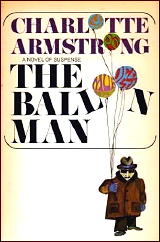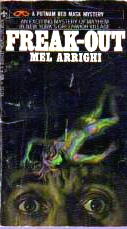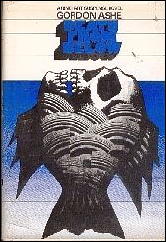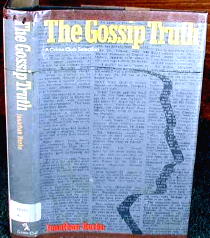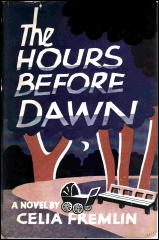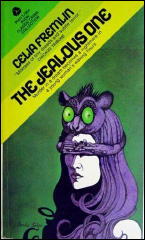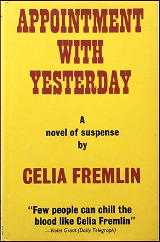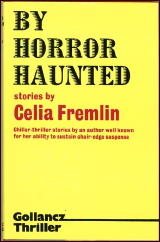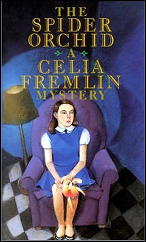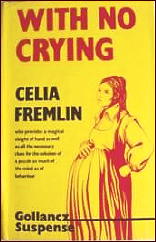September 2009
Monthly Archive
Fri 4 Sep 2009
Posted by Steve under
Reviews[7] Comments
Capsule Reviews by ALLEN J. HUBIN:
Commentary on books I’ve covered in the New York Times Book Review. [Reprinted from The Armchair Detective, Vol. 1, No. 4, July 1968.]
CHARLOTTE ARMSTRONG – The Balloon Man. Coward-McCann, hardcover, 1968, $4.95. (Paperback reprints: Fawcett Crest T1255, 1969; IPL, 1990. Film: Films de la Boetie, 1970, as La Rupture (The Breakup).)
Miss Armstrong weaves impressive magic about some familiar ingredients: a young mother, her son, her weak and failure-prone husband and his unyielding and unloving father.
MEL ARRIGHI – Freak-Out. G. P. Putnam’s Sons, hardcover, 1968, $4.50. (Paperback reprint: Berkley X1733, 1969.)
This fine first novel introduces an impressively original and amusing protagonist in Harrington, out-at-elbows lawyer. He thrashes unskillfully through a murder case among the psychedelic creatures of the Village scene in New York, searching for a killer who might require his talents.
GORDON ASHE – Death From Below. Holt Rinehart & Winston, hardcover, 1968, $3.95. (UK hardcover edition: John Long, 1963. Paperback reprint: Popular Library 01492, no date.)
This is John Creasey writing about Patrick Dawlish and his Crime Haters organization. Creasey demonstrates his very capable handling of the widespread, apparently unmotivated conspiracy of death.
LIONEL BLACK – Outbreak. Stein and Day, hardcover, 1968, $4.95. (UK hardcover edition, Cassell, 1968. Paperback reprint: Stein & Day, 1985.)
This is a tightly plotted and fast moving thriller involving doctors and unpleasant characters with epidemic disease in London.
JONATHAN BURKE – The Gossip Truth. Doubleday & Co./Crime Club, hardcover, 1968, $3.95. (UK hardcover edition published as Gossip to the Grave: John Long, 1967.)
A most entertaining little puzzle of a London gossip column invention that came to life.
Fri 4 Sep 2009
REVIEWED BY DAN STUMPF:
WUTHERING HEIGHTS. 1954. Originally released as Abismos de pasión. Irasema Dilián, Jorge Mistral, Lilia Prado, Ernesto Alonso, Francisco Reiguera, Hortensia Santoveña, Jaime González Quiñones, Luis Aceves Castañeda. Based on the novel by Emily Brontë. Director: Luis Buñuel.
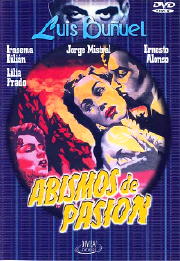
I’ve seen three films of Wuthering Heights and they all cut out the last hundred pages of the book
Q: The last hundred pages? How big a book is it?
A: Oh, about 250 pages.
Q: And they cut out the last hundred?
A: Right.
Q: Damn!
A: Damn indeed, as you so aptly put it.
Luis Buñuel’s 1954 film goes them one better by also cutting out the first thirty pages. Assuming one has maybe a passing acquaintance with the classics, he kicks things off with Heathcliff’s return and his pursuit of the married Cathy — or failing that, her sister-in-law — to work his nasty love/revenge, all this set in contemporary Mexico.
On the surface that might seem a brutal travesty of Emily Brontë’s novel, but Buñuel gives it a sensitivity and passion wholly suited to the subject. His Heathcliff bristles with Byronic angst, played effectively against a compulsively-impulsive Catherine whose fiery Latin temperament suits the character perfectly, and the Mexican landscape somehow evokes the spirit of the lonely moors… perhaps something to do with the Moorish architecture, but I may have my moors mixed.
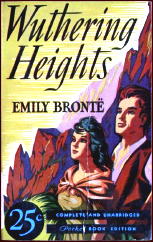
Whatever the case, Buñuel conjures up Brontë’s characters and atmosphere perfectly, and when he tacks on his own original ending, it seems perfectly in keeping with the spirit of the thing … and memorably creepy in its own way.
Anyway, watching this led me to pick up the book again for the first time since high school (I remember thinking there weren’t enough explosions in it.) and, though Emily hardly needs endorsement from the likes of me, I found it an incredibly good bit of writing.
The main characters are all surly, short-sighted and self-absorbed, but somehow they gain our sympathy and never lose our interest. And those last hundred pages…
I can only say that the ending of this book, while hardly cinematic, is one of the best things I’ve read this year.
Thu 3 Sep 2009
ARSON, INC. Lippert Pictures, 1949. Robert Lowery, Anne Gwynne, Edward Brophy, Marcia Mae Jones, Douglas Fowley, Maude Eburne, Byron Foulger. Director: William Berke.
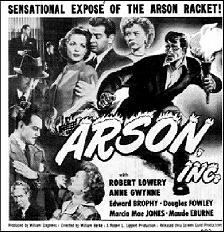
If you recognize any of the names of the members of the cast above, you ought to make a fortune on any Quiz Show that focuses on the movie entertainment industry. If you were to gather that this was a low budget production, you’d be absolutely right. If more than a thousand dollars was spent in the making of this movie, I’d be surprised.
And of course I’m exaggerating, but not by much. This is the last movie I’ve watched in a DVD set of Forgotten Noir (Volume One), not that it’s noir, only a Bargain Basement crime movie in black-and-white made in the 1940s, and therefore…? It has to be noir.
Arson, Inc. begins as a semi-documentary about the fire-fighting business, then segues quickly into a story of an undercover member of the arson squad (Robert Lowrey) who’s on the trail of a gang whose specialty is burning down warehouses supposedly filled with furs.
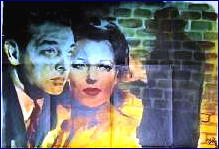
Along the way he meets a schoolteacher (Anne Gwynne) who along with her canny old grandmother (Maude Eburne) moonlights as a babysitter. She also soon becomes his girl friend, and by “she,” I do not mean the grandmother.
Anne Gwynne is another in a long line of good-looking Hollywood actresses whose careers never got out of low, by which I mean B-movies like this one. A sizable role in House of Frankenstein (1944) may have been the height of her career.
Likewise goes for good-looking Robert Lowrey, whose career was longer than his co-star, including stints as Bill Gray, Indian Commissioner, in Cowboy G-Men and as a semi-regular as Buss Courtney in Pistols ‘n’ Petticoats, not that I’m telling you out of past experience, mind you. I’m only repeating what I’ve been told on IMDB.
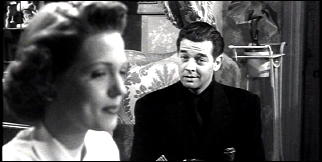
And speaking of IMDB, those who’ve left comments there generally liked this movie one whole quantum leap more than I did.
Any crime movie in which the gangsters and goons at a gangsters and goons late-night party stand around and sing “Little Brown Jug” does not stand much of a chance of getting a high rating from me.
Don’t blame the actors and actresses, though. They’re all professionals, and to a man and woman, they all know what they’re doing. I tend not to blame the directors very much in movies like this either, as they had little control over the stories they were asked to film, and even less over the money they were allowed to spend. William Berke does a good job with what he has to work with.
Thu 3 Sep 2009
A 1001 MIDNIGHTS Review by Bill Crider:
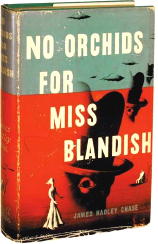
JAMES HADLEY CHASE – No Orchids for Miss Blandish. Howell Soskin, US, hardcover, 1942. UK edition: Jarrolds, hardcover, 1939. Revised edition: Panther, UK, pb, 1961; Avon, US, pb, 1961. Reprinted many times, in both hardcover and paperback. Film: Alliance, 1948. Also: Cinerama, 1971, as The Grissom Gang.
Since the publication of No Orchids for Miss Blandish, James Hadley Chase has sold millions of copies of his more than eighty novels. A British writer who uses mostly American characters and settings in his works, Chase has a fast-paced, hard-boiled style perfectly suited to his violent, action-filled novels.
The title character of Miss Blandish is a young socialite who is kidnapped by small-time hoods and then kidnapped from them by the members of the Grisson gang, a group based on the notorious Ma Barker and her sons.
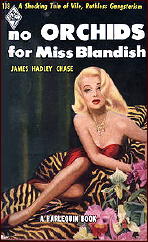
Ma Grisson’s favorite son, Slim, a vicious, perverted killer, takes a special interest in Miss Blandish; so instead of killing her when the ransom is paid, Ma gives her to Slim—
She is kept in a narcotic haze by Doc, another of the gang, so that she will submit to Slim’s debased desires. Eventually, Miss Blandish’s father hires Fenner, a former crime reporter turned private eye, to find his daughter.
There is a bloody shoot-out between the gang and the police, but Slim escapes with Miss Blandish. He is finally cornered, but this is not the sort of story in which everyone can live happily ever after.
Chase does a fine job in Miss Blandish (even in the revised edition of 1961) of understating the sex and violence, which become more effective than if they had been spelled out.
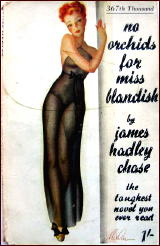
The pace never lags, and the ending is very well handled. Miss Blandish is no longer as shocking as its reputation might suggest, but it remains a powerful crime novel.
Chase’s novels were well suited to the needs of the early paperback market, and many of them are highly sought after by collectors, as much for their colorful titles and gaudy covers as for their contents.
Examples include Twelve Chinks and a Woman (Avon, 1952) and Kiss My Fist! (Eton,1952).
———
Reprinted with permission from 1001 Midnights, edited by Bill Pronzini & Marcia Muller and published by The Battered Silicon Dispatch Box, 2007. Copyright © 1986, 2007 by the Pronzini-Muller Family Trust.
Thu 3 Sep 2009
A MOVIE REVIEW BY DAVID L. VINEYARD:
LOVE IS A BALL. United Artists, 1963. Released in the UK as All This and Money Too. Glenn Ford, Hope Lange, Charles Boyer, Ricardo Montalban, Telly Savalas, Ruth McDevitt, Ulla Jacobsson, Laurence Hardy. Based on the novel The Grand Duke and Mr. Pimm by Lindsay Hardy. Directed by David Swift.
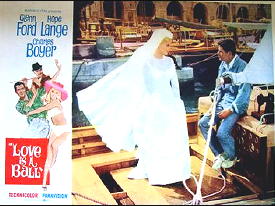
This handsome little romantic comedy is beautifully shot on the Riviera in gorgeous color and Cinemascope, with a professional cast all elevating the slight story with good performances.
John Lathrop Davis (Ford) is a Riviera boat bum, or he would be if he could get his boat in the water. He used to drive Formula One race cars, but now his only ambition is to raise enough money to get his boat afloat and eat regularly, which is where M. Etienne Pimm (Boyer) comes in.
The ensuing light-hearted con game squeaks it by on Mystery*File — but only just.
Mr. Pimm is a matchmaker. He marries minor European royalty to well-to-do Americans taking the tour and doing the Riviera for the summer.
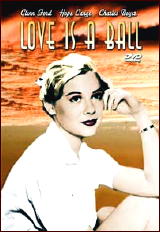
His latest target is one Millicent (Millie) Mehaffey (Lange, and why the name in the film is changed from the books Anabell “Madcap” Mahaffey is one of those mysteries that will never be solved), very rich and very American and very much under the watchful eye of uncle Telly Savalas. The minor nobleman in question is Duke Gaspard Ducluzeau (Montalban).
And the duke — Grand Duke no less — has almost everything but money. He’s handsome and gentle, and a complete and utter klutz.
Ford is hired to turn the clueless duke into the suave gentleman he is supposed to be, along with a team of experts. Ford is to teach him to ride, drive, and behave as a sportsman. No easy job. The duke is an accident waiting to occur.
And then the worst happens. Their in-man at the Mehaffeys gets hurt, and they need a man on the inside if Pimm’s plans are to work. So Davis is voted in to do the job as the new chauffeur — which throws him head long into the arms of Millie, who is as much of a write-off as the Duke, a tomboy fascinated by racing cars and engines and about as demure as a long distance trucker — something her uncle (Savalas) is trying to do something about — like marrying his very rich niece to a Grand Duke.
If you can’t guess where this is going you have never seen a movie, much less a romantic comedy.
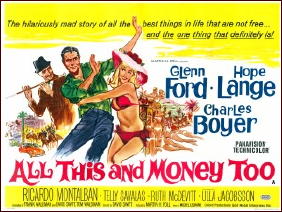
There is nothing special here. It looks wonderful, and if the great cast tries a bit too hard once in a while, the movie still has sparkle and wit. Montalban is fine in the comedy role, a reminder that he was always at ease and personable in this kind of froth, and Ford’s world weary frustration is perfect for the bemused Davis. No one but Cary Grant did frustration as well on screen. Boyer is his charming self, and Savalas was always at his best in comedy, where his overplaying is usually a plus and not a minus.
Lindsay Hardy, who wrote the book, might be better known to readers here for two good thrillers he penned about Major Gregory George Athelston Keen (of the Special Service of Home Security, aka MI5), Requiem for a Redhead and The Nightshade Ring. The two books were well done, and it is a shame there aren’t more.
But this is a charming little film, nothing major, but an easy time passer, and beautiful eye candy.
Note: I don’t know if Laurence Hardy is any relation to Lindsay Hardy. He plays the role of Priory, one of the team hired by Pimm to educate the duke.
TCM Alert: Scheduled to be shown next on Monday, September 14, at 4:15 AM. Set your timers now!
Thu 3 Sep 2009
Posted by Steve under
Reviews[6] Comments
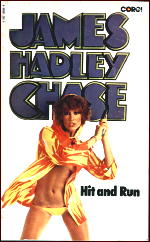
JAMES HADLEY CHASE – Hit and Run.
Corgi, UK; paperback reprint; 1st Corgi printing, 1978. Earlier paperback edition: Panther, UK, 1967. First published in hardcover as by Raymond Marshall: Robert Hale, UK, 1958. No US edition. Film: Groupe des Quatre, 1959, as Delit de Fruite (Hit and Run) Also: Cinestar, 1986, as Rigged.
I’m going to start with a long quote to start my comments off with, and when you’ve read it, I’m positive that you will know (1) what James Hadley Chase’s world of crime fiction is all about, and (2) exactly where this particular story is going next. The narrator is Chester Scott, an up-and-coming California adman; the woman is his boss’s young wife. This interlude takes place while his boss is laid up with a bum leg. From pages 14-15:
The carpet on the stairs was thick and muffled my footfalls. I guess that was why she hadn’t heard me coming down.
She was standing before a full-length mirror, looking at herself, her hands lifting her long, chestnut-coloured hair off her shoulders, her head a little on one side. She had on one of those fancy things called shorties that reached only to within four inches of her knees. Her legs and feet were bare.
She was the loveliest thing I have ever seen in my life. Maybe she was twenty-two, but I doubted it, twenty would be nearer it. She was young and beautiful and fresh, and everything about her was exciting from her thick, long glossy hair to her small bare feet.
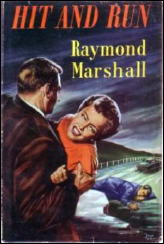
The sight of her touched off a spark inside me that had been waiting to be touched off ever since I had become what is technically known as a man, and which no woman had up to now succeeded in touching off.
The spark ignited with flash that knocked me mentally backwards and sent a flame though me that dried my mouth, made my heart pound and left me breathless.
I stood motionless in the semidarkness looking at her, aware that my blood was racing, my heart was thumping and aware that l had never seen a woman I wanted so badly as this one.
Maybe she had an instinctive feeling that she was being watched or maybe she had finished admiring herself in the mirror; anyway, she suddenly stepped back out of my sight, and the door was pushed to.
For perhaps ten seconds I stood motionless, staring at the half-closed door, them I went on down the stairs, down the next flight to the hall. It was only when I reached the hall that I paused to take out my handkerchief and wipe my sweating face.
Whew! Too bad the rest of the book is not as good as this, but as a matter of fact, it almost is. Chester spends the next few days giving Lucille (that’s her name) driving lessons in his shiny new Cadillac, then the story takes off in an acute angle and not one I expected.
Even though the affair is never consummated, after a would-be lovers’ quarrel, Lucille takes off in a car, only to kill a local cop in a fatal hit-and-run accident. Blackmail comes next and so do several other twists that I have absolutely no business at all in telling you about.
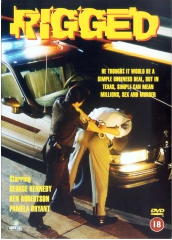
It is a Woolrichian nightmare that Ches finds himself in — or pure noir, no matter how you define it — without the distinctive Woolrichian prose. Chase’s own flair for words, as you will have seen, is serviceable enough, however, and then some. This is the smoothest (and paradoxically the crudest) crime novel I’ve read in a long time. Crudest in the most positive sense of the word, mind you!
PostScript. The movie Rigged (1986) that’s based on this film is available on DVD, somewhat to my surprise, and I’ve just ordered it from the Amazon-UK website. Hopefully I’ll be reviewing it sooner rather than later. For the record now, the movie stars Ken Roberson and Pamela Jean Bryant (both unknown names to me) and George Kennedy as her husband and Roberson’s boss.
Wed 2 Sep 2009
DUSTY RICHARDS – Servant of the Law. St. Martin’s, paperback original; 1st printing, December 2000.
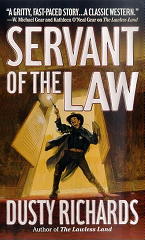
What this novel of the American Old West has is a severe case of split personality. On one side is the Coyote Kid, a born killer, a hired gun with no compunction at ending the lives of those he’s employed to eliminate.
On the other is the title character, Marshal John Wesley Michaels, as upright and square-shooting as any of the cowboy heroes whose exploits I used to follow in the Saturday movie matinees of days (long) gone by.
The Coyote Kid’s exploits are bloody and (seemingly) lovingly described in all of their gory detail. John Wesley is polite to women, kind to animals, and generally just a nice fellow to have around town. In all honesty, I imagine that most of the inhabitants of Arizona at this time of history fell somewhere in between.
Aiding the marshal, in this which may become the first of a series, is Mrs. Arnold (as he calls her), the mother of a small boy accidentally shot and killed by the Kid, and she thirsts for vengeance. A male-female team of intrepid law-enforcers? It might make for interesting reading, but for historians, I imagine it’s going to take a few hefty swallows before it goes down, if at all.
— Reprinted from Durn Tootin’ #3, October 2003 (slightly revised).
[UPDATE] 09-02-09. As it so happened, this book was actually #2 in a slightly different series, one of three books, I think, in Dusty Richards’ “Territorial Marshal” series. Here’s a description taken from Book #1, The Lawless Land (May 2000):
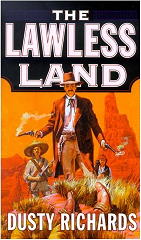
“In 1880, Arizona Territory was an outlaw’s paradise. […] Then a military man named [Major] Bowen stepped in with a plan: find a few good men, call them marshals, and send them after the Border Gang.”
John Wesley Michaels is one of those marshals, and I don’t believe that he or Mrs. Arnold made another appearance. Book #3 in the series was titled Rancher’s Law, and came out in July 2001. If there were more, I don’t know about them.
Since Servant of the Law came out, Dusty Richards has also written one book in the Rodeo Riders series; four books in Ralph Compton’s Trail Drive series; two books about Herschel Baker, Sheriff of Yellowstone County; and five or so standalone westerns.
From the looks of things, it looks like he’s doing a yeoman’s job in upholding the traditions of what I think of as the old-fashioned western. Even if I wasn’t as enthusiastic as I might have been for Servant of the Law, I think I should have been reading more of his work all along.
Wed 2 Sep 2009
REVIEWED BY WALTER ALBERT:
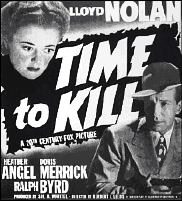
TIME TO KILL. 20th Century Fox, 1942. Lloyd Nolan, Heather Angel, Doris Merrick, Ralph Byrd, Richard Lane, Sheila Bromley, Morris Ankrum, Ethel Griffies. Screenplay by Clarence Upson Young based upon Raymond Chandler’s The High Window and Brett Halliday’s character, Michael Shayne. Director: Herbert I. Leeds. Shown at Cinevent 41, Columbus OH, May 2009.
Fox would remake The High Window as The Brasher Doubloon, with George Montgomery as Philip Marlowe, but although I must confess I have not seen that film or read the novel, I can’t imagine a more entertaining version — albeit performed at express train speed — than the sixty-one minute treatment in Time to Kill. Nor can I imagine a more effective and sympathetic protagonist than the always entertaining Shayne as incarnated by Lloyd Nolan.
The plot is something of a mess, with enough characters and red herrings for two, maybe even three short films. For the life of me, I couldn’t give you a coherent summary of the film, but I can assure you that I wasn’t bored for a minute. It ends rather abruptly, but Nolan never msses a beat as he exits from the series, most appropriately in a taxi with his latest flame. Mike, we still miss you.
Wed 2 Sep 2009
A 1001 MIDNIGHTS Review by Marcia Muller:
CELIA FREMLIN – The Hours Before Dawn. Victor Gollancz, UK, hardcover, 1958. J. B. Lippincott, US hardcover, 1958. Reprint US paperbacks: Dell D422, 1961; Dell 3770, Great Mystery Library, 1966.
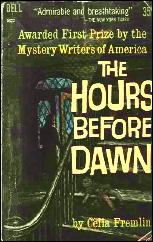
Celia Fremlin has the unusual ability to take a perfectly normal, if not mundane, situation and create an atmosphere of sheer terror. The Hours Before Dawn, which won an Edgar for Best Novel of its year, introduces us to Louise Henderson, a sleep-starved young housewife with a fretful new infant that is causing complaints from both her family and neighbors.
The only person who doesn’t complain is Miss Vera Brandon, the boarder the Hendersons have recently taken in. In fact, Miss Brandon is so self-effacing and quiet that at times the Hendersons don’t even know she is in the house.
Soon the boarder’s actions begin to arouse Louise’s suspicions, and she finds herself doing all sorts of things she has never done before — attempting to search the woman’s room, contacting total strangers for information about her, and finally taking the baby for a nocturnal stroll in his pram, only to fall asleep and lose him in a park.
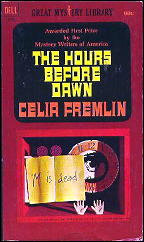
The author skillfully weaves truly frightening events into Louise’s daily routine of meals, housecleaning, and childcare, and her superb characterization has the reader thoroughly on Louise’s side — and just as terrified as she is — by the time the story reaches its surprising conclusion.
Other Fremlin titles of note: Uncle Paul (1960), Prisoner’s Base (1967), The Spider-Orchid (1978), With No Crying (1981).
———
Reprinted with permission from 1001 Midnights, edited by Bill Pronzini & Marcia Muller and published by The Battered Silicon Dispatch Box, 2007. Copyright © 1986, 2007 by the Pronzini-Muller Family Trust.
CELIA FREMLIN, R.I.P. It was Martin Edwards who first made known the news of mystery writer Celia Fremlin’s passing, announcing it on his blog three days ago.
She died this past summer in a nursing home in Bournemouth, on June 16th, with very few in the world of mystery fandom knowing about her passing until now.
Besides Martin’s appreciative tribute to her work, plus a long array of followup comments, a longer obituary by Rebecca Tope can be found online here. She says in part, in one poignant paragraph:
“Her personal life was, in fact, full of tragedy. From the death of her mother when she was seventeen, she went on to lose three children and two husbands, before going blind and slowly sinking into a twilight world that lasted for several years. Her books are light and humorous at first glance, but just below the surface is an acknowledgment of the truly terrible things that can happen to a person. Her style is distinctive and the books immensely enjoyable.”
BIBLIOGRAPHY: Taken from the Revised Crime Fiction IV, by Allen J. Hubin:
FREMLIN, CELIA. Pseudonym of Celia Margaret Goller, 1914-2009. UK publishers only, except for one case of a US retitling:
The Hours Before Dawn (n.) Gollancz 1958.
Uncle Paul (n.) Gollancz 1959.
Seven Lean Years (n.) Gollancz 1961. US title: Wait for the Wedding, Lippincott 1961.
The Trouble Makers (n.) Gollancz 1963.
The Jealous One (n.) Gollancz 1965.
Prisoner’s Base (n.) Gollancz 1967.
Possession (n.) Gollancz 1969.
Don’t Go to Sleep in the Dark (co) Gollancz 1970.
Appointment with Yesterday (n.) Gollancz 1972. No US edition.
By Horror Haunted (co) Gollancz 1974. No US edition.
The Long Shadow (n.) Gollancz 1975.
The Spider-Orchid (n.) Gollancz 1977.
With No Crying (n.) Gollancz 1980.
The Parasite Person (n.) Gollancz 1982.
A Lovely Day to Die, and other stories (co) Gollancz 1984.
Listening in the Dusk (n.) Gollancz 1990.
Dangerous Thoughts (n.) Gollancz 1991.
Echoing Stones (n.) Severn 1993.
King of the World (n.) Severn 1994.
Tue 1 Sep 2009

RIO CONCHOS. 20th Century-Fox, 1964. Richard Boone, Stuart Whitman, Tony Franciosa, Jim Brown, Wende Wagner, Edmond O’Brien. Based on the novel Guns of Rio Conchos (Gold Medal, 1958) by Clair Huffaker (also co-screenwriter). Director: Gordon Douglas.
If you were trying to track down several wagons full of stolen Army rifles, and you were the colonel of the fort in charge, who would you send on a mission to find them, using as bait another wagon filled with barrels of gunpowder?
Surely not a surly ex-Confederate officer named Lassiter (Richard Boone) and a womanizing half-breed Mexican rogue with flashing eyes and surreally white teeth and otherwise about to be hanged (Tony Franciosa)?
Along with, of course, Captain Haven (Stuart Whitman), the officer who was responsible for the rifles being stolen in the first place, and a black cavalry sergeant (Jim Brown), and you have a team made in heaven.

Or not.
Along the way, meeting both bandits and Apaches in approximately equal number the band of four, they add a fifth member to their number, a beautiful Indian woman (Wende Wagner) who at least is brunette and not blonde.
After several days of assorted misadventures, they at last meet the man who has the guns, Colonel Theron ‘Gray Fox’ Pardee (Edmond O’Brien), Lassiter’s former commanding officer, who intends to use his newly gotten arms to help the South rise again.
I have heard the phrase “chewing the scenery” many times before, but I don’t think I ever I knew what it meant until seeing Edmond O’Brien in action in this movie, not that it’s exactly what the part calls for.

Richard Boone as a hero (Paladin, say) has always rated an “A Plus” in my book, but if anything, he is always better as a villain, or in this case a man consumed with hatred toward the Apaches, who killed his wife and child well over a year ago.
Boone is a master of not-so-veiled sarcasm and an inner rage that threatens to boil over at any instant. (He is at his utter hard-boiled best villainy, by the way, in a spy film called The Kremlin Letter, 1970, an absolute must see, even if it is mostly incomprehensible in its complexity.)
This was Jim Brown’s debut film, and he is allowed to say perhaps fifteen words during the whole movie. That does not mean that his presence goes unnoticed, nor does that of Wende Wagner, later well-known for playing Miss Case on The Green Hornet TV series. (She has several lines of dialogue in Rio Conchos, but not one in English. I would someday like to know what language — Apache? — she does speak.)

And why no one has put the The Green Hornet TV series out on DVD is a question for which I have no answer. But I digress.
Rio Conchos is a movie that is entertaining all the way through, and while it reaches no heights of glory, if you are a western movie fan, it is well worth your undivided attention.
And if you do watch this moving picture all the way through, there is an added bonus.
You get to make up your own ending.
It ends a bit abruptly, it does.
« Previous Page — Next Page »
